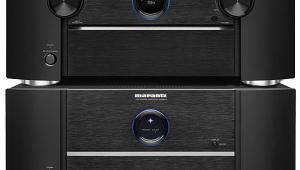Class Act: Amplifier Classes Explained Page 2
Class E and F
Very high-speed switching amps, conceptually variants of Class D (more on this below). Not found in any audio circuits we know of. You can forget about these, too—I just didn’t want you to think audio engineering skipped these letters because they’re somehow “bad,” as is done in certain misguided letter-grading systems.
Class G
In both A and A/B designs the power-supply rails—the positive and negative voltages that the output devices control and the raw material of amplification—are kept more or less “on,” at or near their maximum voltages all the time, even while the audio signal is small, at a substantial cost in efficiency and heat. Class G addresses this by introducing multiple rail voltages (usually just two, lower and higher), and switching between them as dictated by the incoming signal level: at low-demand inputs just the lower rail will suffice, but as demand increases—meaning just the tippy-top peaks of moderate-level signals, but more in higher-volume operation—the output devices will draw from the higher rail during the peak portion of each half-wave. The drawback is added circuit complexity and thus cost, and the delicate design challenge of keeping the rail-transition point from creeping into the amplified audio output as added distortion.
Class H
Similar concept to Class G, except instead of switching between multiple discrete rail voltages, the single rail’s voltage is adjusted in real time to “bulge/sag” as it tracks the peak needs of the incoming signal. As the signal gets larger the rail voltages get higher, falling to a set minimum level at lower demands. More efficient still, but even more complex and tricky to design (and thus costly), though potentially slightly lower distortion in some views.
Class G/H
This design is are widely found among large pro-sound power amps, where multi-kilowatt channels are routine. It’s almost not hyperbole to say that the heat and power they save made arena-rock possible without backing up Niagara Falls. A small handful of current-day consumer AV receiver and power-amp designs employ Class G with Class H’s savings of heat, size, and weight.
Class D
Now we return to the amplifier class getting most of the attention these days. In a Class D amp, the power supply in one sense is the amplifier. Here’s how it works: the incoming audio waveform is compared to a reference waveform many times per second (usually more than 60 or 70 thousand), and generates a train of low-power, fully-on/fully-off “pulses,” such that the density of the pulses can be reconstructed into a perfect analog (or so the designer hopes!) of the input waveform. More-numerous narrow pulses yields a larger waveform value; fewer wider pulses yields a smaller value. These pulses are then applied to control the on/off state—fully—of the output devices: usually MOSFET transistors, but in theory the use of any out device, even tubes, is possible. Think of these output devices operating as valves that are either completely “open” or “closed” with no partial flow in-between. The output of these is in turn run through a fairly simple, passive, high-power-handling low-pass filter that’s not altogether unlike a loudspeaker’s woofer crossover, and—presto!—the amplified audio signal is recovered at high power.Because the high-power output devices are always either fully “on” or fully “off,” Class D is the most efficient (especially when operating at high power output), coolest-running, and most space-saving of all, two to four times more efficient than a typical Class AB design. The inherent forms of distortion and operational quirks of this relatively new class of amplification have been addressed on multiple fronts as well, which is why, along with its efficiency and potential cost savings, we've seen Class D move in recent years from being used only for subwoofer amplifiers or non-critical listening applications to finding increasing favor in audio and AV applications.
To hammer on a personal pet peeve: Class D topology is not a “digital amplifier,” though you will find no shortage of citations referring to it just that. While there is pulse-width modulation involved, there’s no quantization, and without quantization, we’re still in analog-land. So there.
And that’s as much of the alphabet as audio engineering has consumed, at least as far as I know. Do these different classes somehow sound intrinsically different? Many ‘philes think so. I have neither the space nor the inclination to argue the point here, but will reiterate my oft-stated view: That electrons don’t remember where they’ve been. In other words, any amplifier, regardless of class—be it tube, transistor, or hamsters-on-a-treadmill—that fulfills basic parameters of steady-state and transient distortion, low noise, output impedance, and a small host of other requirements can be fully transparent—if operating in its linear region under all conditions and input demands (and that’s a big “if”!).
Class dismissed.
















































